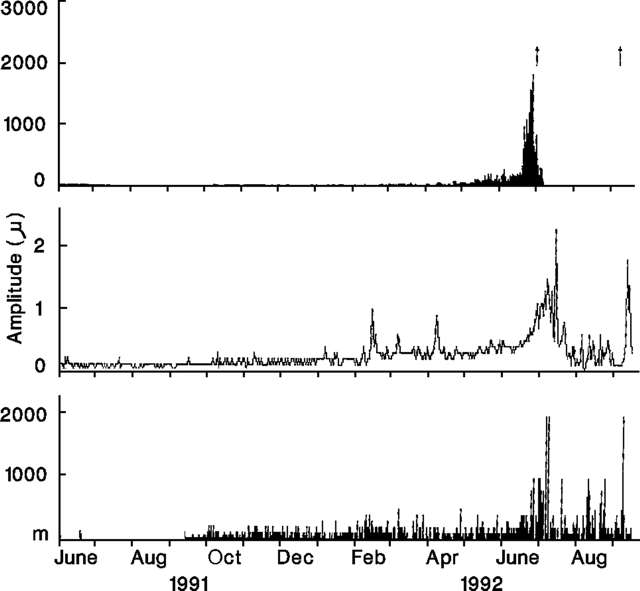Report on Asosan (Japan) — August 1992
Bulletin of the Global Volcanism Network, vol. 17, no. 8 (August 1992)
Managing Editor: Lindsay McClelland.
Asosan (Japan) Explosion ejects blocks
Please cite this report as:
Global Volcanism Program, 1992. Report on Asosan (Japan) (McClelland, L., ed.). Bulletin of the Global Volcanism Network, 17:8. Smithsonian Institution. https://doi.org/10.5479/si.GVP.BGVN199208-282110
Asosan
Japan
32.8849°N, 131.085°E; summit elev. 1592 m
All times are local (unless otherwise noted)
Heavy rains expanded the crater lake in early August but it shrank to cover only 20% of the crater floor later in the month as a result of daily ejections of mud, blocks, and water. Steam emissions were continuous, rising to 1 km on 10 and 24 August.
A strong eruption of water, blocks, and mud from Crater 1 at 1223 on 8 September ejected blocks to 200 m above the crater rim and a 2-km steam plume. Blocks up to 70 cm across were scattered to 300 m W of the crater rim. The eruption was similar in size to the previous eruption on 30 June-1 July, but eruption tremor of 30 µm amplitude was detected by a seismometer 800 m W of the crater, compared to the 9-µm amplitude recorded by the same instrument on 1 July. No changes in tremor activity were recorded before the eruption, although there was an increase in the amplitude of continuous tremor for two days after the eruption (figure 22). There were only 55 isolated tremor episodes in August compared to 1520 in July, with another 35 events recorded in September through the 15th.
Geological Summary. The 24-km-wide Asosan caldera was formed during four major explosive eruptions from 300,000 to 90,000 years ago. These produced voluminous pyroclastic flows that covered much of Kyushu. The last of these, the Aso-4 eruption, produced more than 600 km3 of airfall tephra and pyroclastic-flow deposits. A group of 17 central cones was constructed in the middle of the caldera, one of which, Nakadake, is one of Japan's most active volcanoes. It was the location of Japan's first documented historical eruption in 553 CE. The Nakadake complex has remained active throughout the Holocene. Several other cones have been active during the Holocene, including the Kometsuka scoria cone as recently as about 210 CE. Historical eruptions have largely consisted of basaltic to basaltic andesite ash emission with periodic strombolian and phreatomagmatic activity. The summit crater of Nakadake is accessible by toll road and cable car, and is one of Kyushu's most popular tourist destinations.
Information Contacts: JMA.


